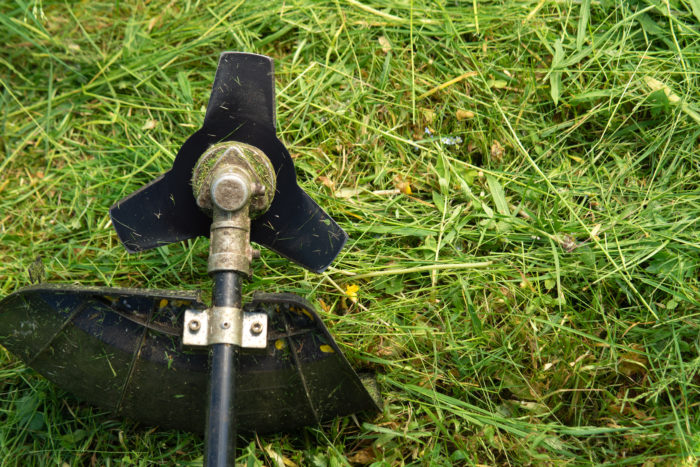A well-kept grass, like well-kept hair, keeps your home looking fresh and attractive to guests. Hence the lawn mower plays an essential part in decorating your home.
It can be difficult to get the right lawn mower for your needs. It could be risky to do so without knowing everything there is to know about them.
However, the most important aspect of selecting the best lawn mower is having a thorough understanding of the many varieties of lawn mower blades.
First, let us have a look at what are the different types of lawn mower blades.
Different Types Of Lawn Mower Blades
Before you buy lawn mower blades, the most important thing to do is learn everything there is to know about them so you can figure out which ones are best for your lawn.
Different types of blades are:
- Standard Blades- Straight mower blades are another name for these. This is the most popular horizontally rotating blade found on most lawn mowers.
The blade’s edges are slightly curled up to provide a continuous airflow as the blade revolves, sucking and cutting the material.
- Low Lift Blades- Low lift blades are designed for side discharge mowing and are suited for mowing sandy terrain.
Because of the low suction force, the design incorporates a less-dramatic swoop than high-lift blades, enabling the cut grass to stay low and expelled out the side of the mower.
- High Lift Blades- High lift air beneath the mower creates the great suction power blade, which has a more vertical swoop shape. High lift blades are useful for bagging because of their fan-like suction.
It also speeds up bagging and lowers the likelihood of chopped grass becoming jammed in the mower’s cutting region. It’s ideal for mowing tall, dense grass. A larger horsepower engine is also required.
- Mulching Blades- An all-purpose blade is also referred to as a mulching blade. It has a curved surface that allows it to be used in three different ways.
The grass is first pulled up and sliced by the blade. The clippings are then pulled into the deck and cut into very little pieces.
Finally, the blade’s innermost curve generates air pressure, which causes the little clippings to be blown out and fed to the soil.
- 3 in 1 Blade or Gator Blades- 3-in-1 blades cover all the basics for an all-around solution. This blade, often known as a “3-in-1” blade, combines a medium-lift with a mulching feature to combine the three grass cutting processes into one blade.
Because of the serrated portions on either end of the blade, gator blades are simple to recognize.
Although using more than one design focus allows for higher lift mulching, 3-in-1 blades fall short in each area, high lift, low lift, and mulching, to achieve that compromise. Despite its popularity, this blade is ideal for all-around lawn cutting.

How To Pick A Particular Blade?
The best thing about a lawnmower blade is that it can balance the machine’s engine power with its pointed end.
But how do you choose a blade like this? Well, it all falls down to three basic considerations.
- Length of the blade – The length of the blade will be the first factor you will inspect. Now, there is no hard and fast rule, but try to remember that longer does not always imply better.
It must be compatible with your lawnmower model. The majority of blades are between 16.75 and 22 inches in length.
Most mowers can accommodate blades up to 21 inches or 22 inches in length. So make the decision based on the model.
- Build material – Regardless of the mower model, you have the option of choosing the blade’s construction material. Lower metal can help you save money, but it won’t help you save money on grass.
Please bear in mind that replacing the blade on your lawnmower is more of a maintenance investment that can affect the mower’s lifespan.
As a result, stainless steel is usually the finest option. Also, inspect the paintwork on the blade to ensure that it does not become corroded.
- Deck Size- Finally, the blade’s deck size should be taken into consideration. The deck size of most push mowers ranges from 16 to 30 inches. Riding mowers have larger deck sizes as well.

The type of blade you choose for your lawn mower also depends on mulching leaves so choose the perfect fit mulching blades for your lawn mower for a beautiful lawn.
How Often Should I Change My Lawnmower Blade?
Now you know which blade to buy according to your model and your needs.
But how often should the blades be replaced? Well, the answer is the duration till your mower blades survive on the quality and the mowing intensity, yet in general, the blades last from 100 to somewhere 200 hours.
Since the duration is determined by how frequently you run your lawnmower, the blades will deteriorate faster if you use it to mow large areas.
The blade may need to be changed if it comes into contact with a rock or tree during mowing.
Otherwise, it’s a good idea to change them once a year just to be cautious.
How to Detect If the Blades are Blunt?
Dull blades reduce the efficiency of cutting the blades. It will tug on the grass, causing jagged edges. The damaged grasses will quickly turn a brownish color, which you will notice.
Using worn blades only adds extra pressure on your lawnmower. So replace lawn mower blades as quickly as possible is necessary.
Conclusion
You now have a basic understanding of the various types of lawn mower blades available. You can now select the lawnmower that best meets your requirements.
Check the blades on a regular basis and change or sharpen them by using sharpening tools as needed. If you mow your lawn with a dull or rusted blade, the grass may become infected with illnesses.

